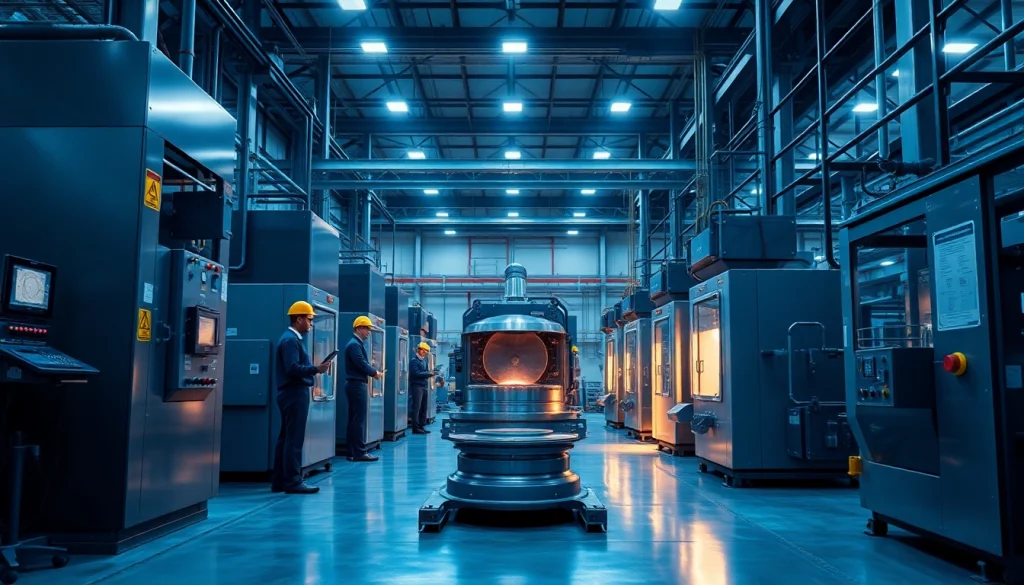Professional Precision Die Casting Malaysia: Essential Insights for 2025

Understanding Precision Die Casting in Malaysia
Precision die casting is a highly regarded manufacturing process in Malaysia, known for its ability to produce intricate and high-quality metal components. This technique plays a crucial role in a variety of industries, including automotive, electronics, and consumer goods. With Malaysia positioning itself as a hub for precision die casting, it is essential to grasp the nuances and advantages this manufacturing method brings to the table. For those considering the viability of precision die casting malaysia, there are multiple factors that can influence quality and efficiency.
What is Precision Die Casting?
Precision die casting is a method that involves forcing molten metal into a mold cavity under pressure. Unlike traditional casting methods, precision die casting achieves greater dimensional accuracy and surface finish, making it suitable for parts that require tight tolerances. This technique is predominantly used with metals like aluminum, zinc, and magnesium, thanks to their excellent fluidity and strength characteristics. The process typically involves two main types of die casting: hot chamber and cold chamber die casting, each serving distinct application needs based on the metal being used.
The Importance of Precision in Manufacturing
In manufacturing, precision translates to efficiency and cost-effectiveness. High precision in die casting allows manufacturers to produce parts that meet strict specifications, minimizing waste and labor costs associated with rework or adjustments. Moreover, precision die casting supports the development of lightweight yet robust components, which is particularly beneficial in industries like automotive where fuel efficiency is paramount.
Industries Benefiting from Die Casting Services
Several industries reap the benefits of precision die casting, including:
- Automotive: The automotive sector requires precise and durable components for engine parts, housings, and structural components.
- Electronics: Die casting is used for manufacturing cases, connectors, and other electronic enclosures that necessitate durability and precision.
- Consumer Goods: Many household appliances and furniture fittings are produced via die casting due to the intricate designs they require.
- Aerospace: Components in the aerospace industry often demand high precision to ensure safety and performance, where every part must meet rigorous standards.
Key Features of Precision Die Casting
Material Options and Their Applications
The choice of material in precision die casting significantly impacts the properties of the final product. Commonly used materials include:
- Aluminum: Lightweight and corrosion-resistant, making it ideal for automotive and aerospace applications.
- Zinc: Offers excellent fluidity, making it perfect for detailed parts in various industries.
- Magnesium: Known for its high strength-to-weight ratio, often utilized in aerospace and automotive sectors.
Choosing the right material not only affects performance but also influences factors like cost, longevity, and adaptability to various environmental conditions.
Quality Control Measures in Die Casting
Quality control in precision die casting is paramount for ensuring that all components meet stringent specifications. Measures include:
- Dimensional Inspection: Regular checks and balances to ensure that all parts meet required tolerances.
- Material Testing: Ensuring that the raw materials used can withstand the intended application.
- Visual Inspections: Checking for visible defects or inconsistencies in the casted parts.
Implementing these measures not only enhances the reliability of the parts produced, but also strengthens the manufacturer’s reputation in the industry.
Technological Innovations in Die Casting Processes
Advancements in technology continuously reshape the landscape of precision die casting. Some key innovations include:
- 3D Printing Patterns: The ability to quickly create complex molds that reduce lead times.
- Computer Numerical Control (CNC): Enhances the accuracy of the machining processes post-casting.
- Automation: Streamlining production processes to reduce labor costs and improve consistency.
These innovations not only improve the efficiency of production but also enhance the overall quality of the products manufactured.
Challenges in the Die Casting Industry
Common Misconceptions about Precision Die Casting
Many misconceptions surround precision die casting. A prevalent myth is that it is only suited for large-scale manufacturing. However, modern die casting techniques and technologies allow for flexibility in volume, serving both small and large batch orders effectively. Understanding the actual capabilities of precision die casting is crucial for businesses looking to leverage its benefits.
Addressing Quality and Cost Concerns
While precision die casting offers numerous advantages, concerns about quality and costs often arise. It’s crucial for manufacturers to invest in high-quality materials and advanced technology to ensure the longevity of the components. A balance must be struck between sourcing affordable materials and maintaining the necessary standards to produce reliable products.
Overcoming Production Bottlenecks
Production bottlenecks can derail efficiency in die casting operations. Common reasons for these issues include inadequate machinery, suboptimal designs, or supply chain disruptions. Businesses must conduct regular assessments of their production lines and workflows to identify potential bottlenecks and implement solutions that enhance overall efficiency.
Strategies for Successful Die Casting Projects
Choosing the Right Die Casting Manufacturer
Selecting a reputable die casting manufacturer is crucial to the success of any project. Factors to consider include their experience, certifications, and customer feedback. A manufacturer with a strong commitment to quality and innovation can significantly impact the outcome of your die casting project.
Design Best Practices for Die Casting
Effective design practices are essential for achieving optimal results in precision die casting. These include:
- Simplicity: Simple designs tend to yield better results, reducing the complexity of the mold and minimizing production errors.
- Draft Angles: Incorporating draft angles facilitates easier removal of the cast from the mold, preventing damage.
- Wall Thickness: Maintaining consistent wall thickness reduces the risk of defects and improves the overall quality of the casted parts.
Planning and Execution of Die Casting Projects
Thorough planning is essential for the successful execution of die casting projects. This includes setting realistic timelines, budgeting, and conducting risk assessments. By anticipating challenges and proactively addressing them, manufacturers can ensure that projects stay on track and within budget.
Future Trends in Precision Die Casting
Emerging Technologies in the Die Casting Market
As the manufacturing landscape evolves, new technologies are emerging that are set to redefine precision die casting. These include advancements in artificial intelligence, which can optimize manufacturing processes by predicting failures and improving scheduling. Furthermore, the integration of machine learning can enhance quality control measures by analyzing production data to identify trends and anomalies.
Sustainability and Environmental Considerations
Sustainability is becoming an increasingly critical consideration in the die casting industry. Manufacturers are exploring methods to reduce energy consumption, recycle materials, and minimize waste. Strategies such as using eco-friendly materials and implementing circular economy principles can help companies meet regulatory standards while promoting environmental responsibility.
Predictions for the Die Casting Industry in 2025
Looking towards 2025, the die casting industry is poised to witness significant transformations. With the rise of electric vehicles, there will be an increased demand for lightweight and precision-engineered components. Additionally, a focus on automation and smart manufacturing practices will likely lead to more efficient production lines, resulting in reduced lead times and enhanced quality assurance across the board.




